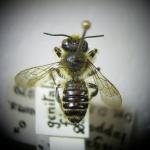Extinct in Britain. A single record from 1847. Else (1999) includes this species in the notes but not the key, although it should be included in his forthcoming monograph. A key is provided in Amiet et al. (2004).
In Britain it is only known from a single record at Weybridge, Surrey, in 1847.
On the continent it is known from Austria, Belgium, Czech Republic, France, Germany, Lithuania, Finland, Sweden, south Russia, Switzerland and Poland. In Denmark it is noted as being common. Further afield, Megachile lapponica is found in the east Palaearctic region.
Shirt (1987) and Falk (1991) list Megachile lapponica as Appendix (extinct) as there are no post-1900 records.
In Germany the species is known from forest edges and clearings. It is not a heat-loving species, being found in montane and boreal forested areas of Europe.
A univoltine species, the bee is reported to be on the wing in Germany from mid-June to August. It can be assumed that it would have a similar flight period in Britain.
As with other leaf-cutter bees, Megachile lapponica nests in wood of varying types and in a variety of situations from tree stumps to fence posts. Reports suggest that the leaves of rosebay willowherb are used to create the brood cells.
It has been reported to forage from Rubus species, willowherbs and Fabaceae.
Coelioxys inermis (Kirby) is reported to be a parasite of Megachile lapponica.
2016


